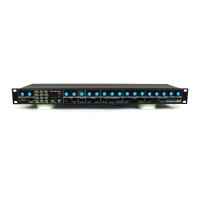
Do you have a question about the Novation Bass Station Rack and is the answer not in the manual?
| Type | Analog |
|---|---|
| Synthesis Type | Subtractive |
| Polyphony | Monophonic |
| Oscillators | 2 |
| Envelope Generators | 2 (ADSR) |
| LFO | 1 |
| MIDI | In, Out, Thru |
| CV/Gate | Yes |
| Keyboard | No |
| Waveforms | Sawtooth, Square, Noise |
| Dimensions | 19" x 1U rack |
Controls output volume, portamento, headphone socket, and program write protection.
Contains buttons for program selection, data entry, display, and mode LEDs.
Controls Low Frequency Oscillator speed, depth, and waveform shape.
Covers Oscillator 1 & 2 waveforms, range, detune, and mixing with external audio.
Details Oscillator 1 & 2 modulation, sync, PWM source, and depth controls.
Manages filter frequency, resonance, modulation depth, and cut-off slope.
Controls for envelope select, triggering, attack, decay, sustain, release, and velocity.
Connectors for interfacing vintage analog synths via CV/Gate to MIDI.
Connector for processing external audio through the filter and envelope sections.
Line-level output signal for connection to mixers or amplifiers.
Connectors for receiving and transmitting MIDI data.
Connector for the 9vDC power adapter.
Visual representation of CV/Gate output connection.
Visual representation of CV/Gate input connection.
Visual representation of audio line output connection.
Visual representation of line level input connection.
Visual representation of MIDI output and input connections.
Visual representation of power supply connection.
Step-by-step guide for initial connection and operation of the unit.
Detailed explanation of Volume, Portamento, Write switch, and Headphone socket.
Explanation of program selection, MIDI channels, utility functions, and save modes.
Function of the Mode button for selecting parameter modes.
Function of the Audition/Demo button for triggering notes and demo mode.
Explanation of the keypad for entering numbers and values.
Selecting sounds using program numbers and MIDI program changes.
Setting the MIDI channel for receiving data.
Setting the MIDI channel for transmitting data.
Accessing and setting various utility functions via the Data Entry keypad.
Setting the semitone range for the pitch bend wheel.
Adjusting pitch modulation depth from a controller wheel.
Adjusting filter modulation depth from a controller wheel.
Setting pitch modulation depth for aftertouch or breath controllers.
Setting filter modulation depth for aftertouch or breath controllers.
Setting envelope generator bias for aftertouch/breath controllers.
Synchronizing the LFO to the MIDI clock rate.
Setting CV/Gate converter MIDI channel and system type.
Enabling polyphonic chaining of multiple BassStation Racks.
Setting the master tuning of the unit.
Methods for loading single sounds via sysex dumps.
How to modify existing programs and the edit LED indication.
Saving edited or new sounds into memory locations.
Detailed steps for saving sounds into ROM and RAM.
Common problems and their possible causes and solutions.
Explanation of subtractive synthesis, oscillators, filter, LFO, and envelopes.
Control for LFO rate and its visual indication.
Control for LFO delay before effect introduction.
Selecting LFO waveform shapes (R'DOM, TRI, SAW).
Controls relative volumes of oscillators and external audio input.
Adjusts fine tuning difference between oscillators.
Sets musical interval between oscillators in semitones.
Selects octave difference for oscillator 2.
Controls pitch modulation amount from Envelope 2.
Controls pitch modulation amount from the LFO.
Controls the width of the pulse waveform.
Selects control source for Pulse Width Modulation.
Synchronizes oscillator 2 cycle with oscillator 1 for timbre changes.
Activates the oscillator synchronization feature.
Guide to setting up a specific sync sound.
Controls the basic cut-off frequency of the filter.
Controls modulation amount for filter cut-off frequency.
Boosts or emphasizes frequencies around the cut-off frequency.
Selects the steepness of the filter cut-off slope (12dB or 24dB).
Selects modulation source (LFO or Env 2) for filter cut-off.
How envelopes shape sound over time for amplitude and other parameters.
Selects which envelope (1, 2, or both) is currently being modified.
Sets how quickly the envelope rises to its maximum level.
Sets how quickly the envelope drops to the sustain level.
Sets the level the envelope remains at after decay.
Sets how quickly the envelope drops to zero after release.
Adjusts how much velocity affects the envelope.
Determines how envelope triggers (Autoglide, Single, Multi).
MIDI controller assignments for filter controls.
MIDI controller assignments for envelope controls.
Synchronizing the LFO to MIDI clock for effects.
Interfacing vintage synths with MIDI devices.
Guide for connecting and configuring CV/Gate to MIDI.
Triggering vintage synths using MIDI.
Using vintage synths to play the BassStation Rack.
Guide to emulating the Roland TB303 sound.
Common problems and their possible causes and solutions.
Technical specifications of the BassStation Rack.
Physical dimensions and weight of the unit.
Explanation of triggering modes (Autoglide, Single, Multi).
Range of portamento settings.
Summary of MIDI features like memory and controllers.
Summary of physical connections.